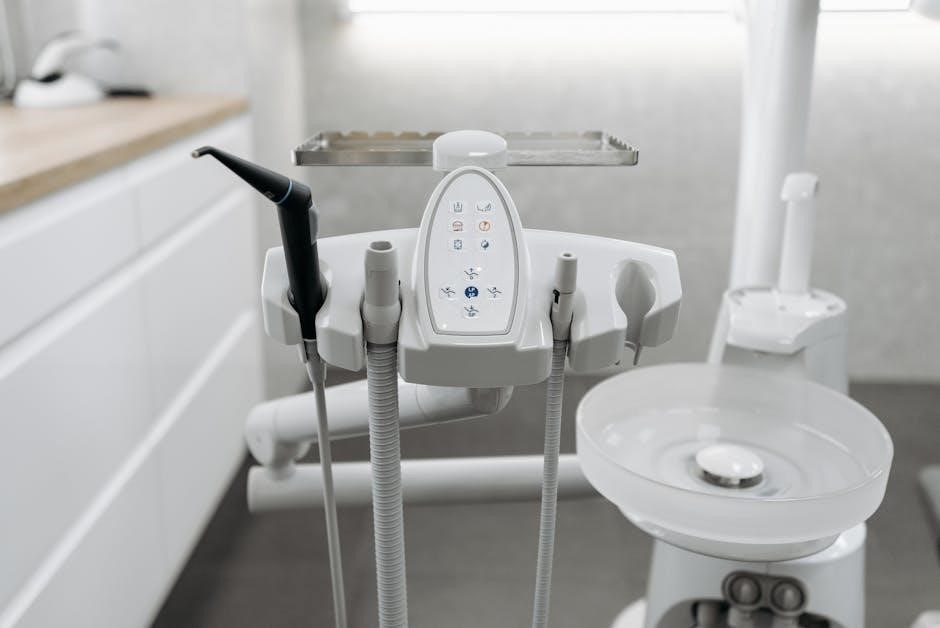Oral motor exercises are essential for improving speech, eating, and swallowing skills. They strengthen facial muscles, enhancing coordination and control. PDF guides offer structured activities for home practice.
What Are Oral Motor Exercises?
Oral motor exercises target the muscles of the face, lips, tongue, and jaw to improve coordination, strength, and mobility. These exercises enhance functions like chewing, swallowing, and speaking. They involve activities such as tongue protrusion, lip exercises, and jaw movements. Tools like mirrors or sticks may be used for visual feedback and coordination. Regular practice helps address issues like speech clarity and feeding difficulties. PDF guides provide structured plans for parents and therapists to implement these exercises effectively, ensuring consistent progress and skill development in children and individuals with oral motor challenges.
The Importance of Oral Motor Skills
Oral motor skills are crucial for effective eating, speaking, and swallowing. They enable proper coordination of the lips, tongue, and jaw, supporting clear communication and safe feeding. Strong oral motor abilities also enhance sensory integration and self-confidence. For children, these skills are foundational for speech development and academic success. Weaknesses in this area can lead to challenges like mealtime struggles or articulation difficulties. Strengthening oral motor skills through targeted exercises improves overall quality of life, making daily interactions and nutrition more manageable and enjoyable for individuals of all ages.
Benefits of Oral Motor Exercises
Oral motor exercises enhance speech clarity, improve eating and swallowing abilities, and boost confidence in communication. They strengthen facial muscles, improving coordination and overall oral function, with PDF guides offering structured routines.
Improved Speech Clarity
Oral motor exercises significantly enhance speech clarity by strengthening the muscles used in articulation. Activities like tongue movements and blowing games improve coordination, helping children produce sounds more accurately. These exercises also boost control over lip and jaw movements, reducing speech intelligibility issues. PDF guides often include specific routines to target articulation difficulties, making them invaluable for parents and therapists. Regular practice fosters better communication skills, enabling clearer expression of thoughts and ideas. This, in turn, builds confidence and eases social interactions, making speech more effective and engaging.
Enhanced Eating and Swallowing Skills
Oral motor exercises improve eating and swallowing by strengthening the muscles used in these processes. Activities like chewing exercises and sensory play help children manage textures and transitions to solid foods. PDF guides often include routines to address sensory sensitivities, ensuring mealtimes are less stressful. These exercises also enhance coordination between the tongue, lips, and jaw, making swallowing safer and more efficient. Regular practice fosters better feeding habits, reducing challenges with mealtime and promoting overall nutritional well-being. This makes oral motor exercises a vital tool for improving eating and swallowing skills in children.
Boosted Confidence in Communication
Oral motor exercises significantly enhance confidence in communication by improving speech clarity and reducing struggles with articulation. As children gain better control over their tongue and lip movements, they experience fewer difficulties in expressing themselves. This leads to increased self-esteem and a willingness to engage in conversations. PDF guides often highlight success stories where these exercises transformed a child’s ability to communicate effectively; By mastering oral motor skills, children feel more confident in social interactions, making communication a more enjoyable and empowering experience. This boost in confidence is a powerful outcome of consistent practice and structured activities.
Types of Oral Motor Exercises
Oral motor exercises include tongue, lip, and jaw movements, blowing activities, and chewing or biting drills. These exercises improve coordination, strength, and control, enhancing overall oral function.
Tongue Exercises
Tongue exercises are crucial for improving oral motor skills. Activities like protruding the tongue side-to-side and holding it steady enhance strength and coordination. Using tools such as tongue depressors or spoons can guide movement. These exercises help children develop better control over their tongue, aiding in clearer speech and effective eating. Regular practice, combined with visual feedback from mirrors, ensures progress and mastery of tongue movements. Consistency in these exercises fosters improved oral function and overall communication abilities.
Lip Exercises
Lip exercises are designed to strengthen and improve the coordination of lip muscles. Activities like blowing bubbles or holding small objects with the lips enhance control and endurance. These exercises aid in developing proper oral motor skills, which are essential for clear speech and effective eating. By incorporating fun and engaging techniques, children can practice lip exercises effortlessly. Regular practice helps build confidence and improves overall communication abilities, making these exercises a vital part of oral motor development. Consistency and creativity ensure lasting benefits for speech and feeding skills.
Jaw Exercises
Jaw exercises target the muscles responsible for chewing, speech, and maintaining proper oral posture. Activities like opening and closing the mouth slowly or moving the jaw from side to side improve strength and coordination. These exercises help address issues like misalignment or limited mobility. Using tools like a tongue depressor to guide jaw movements can enhance precision. Regular practice promotes better chewing and swallowing abilities, reducing difficulties during meals. Strengthening the jaw muscles also supports clearer speech and overall oral motor function, making these exercises a fundamental part of oral motor development programs for children and individuals with motor challenges.
Blowing and Breath Control Exercises
Blowing exercises are a fun and effective way to improve breath control and oral motor skills. Activities like blowing bubbles, using a straw to move objects, or creating raspberry sounds engage the lips and tongue. These exercises strengthen the diaphragm and intercostal muscles, enhancing respiratory support for speech. They also improve coordination between breathing and articulation, making speech clearer and more controlled. Incorporating games like blowing feathers or small balls across a table adds an element of play, motivating children to practice consistently. Such exercises are particularly beneficial for children with speech or swallowing difficulties, promoting overall oral motor development. Regular practice fosters better breath management, essential for sustained speech and confident communication.

Assessment and Identification
Identifying oral motor challenges involves observing signs like difficulty chewing, speaking, or swallowing. Professional assessments, including visual feedback and specific tests, help determine the need for targeted exercises.
Signs Your Child May Need Oral Motor Exercises
Children may show signs such as difficulty chewing, drooling, or unclear speech. They might struggle with swallowing or avoiding certain foods. Sensory sensitivities, like discomfort with textures, can also indicate the need for oral motor exercises. If your child has trouble coordinating lip, tongue, or jaw movements, or exhibits delays in speech development, it may be time to consult a professional. These exercises can address underlying muscle weaknesses and improve overall oral function, leading to better eating, speaking, and confidence.
How to Assess Oral Motor Skills
Evaluating oral motor skills involves observing a child’s ability to coordinate lip, tongue, and jaw movements. Use mirrors for visual feedback to assess tongue protrusion and lateral movement. Check for signs like drooling, unclear speech, or difficulty chewing and swallowing. Note sensory sensitivities to textures or tastes. Speech clarity and articulation are also key indicators. Consult speech-language pathologists for standardized assessments. PDF guides offer structured activities and checklists to identify needs and provide appropriate exercises for improvement.

Safety Guidelines
Ensure exercises are done safely by stopping if pain, dizziness, or breathing difficulties occur. Allow rest periods, maintain oral hygiene, and use proper posture and mirrors for feedback.
When to Stop Exercises
Immediately stop oral motor exercises if pain, dizziness, or difficulty breathing occurs. Consult a doctor or therapist if these symptoms persist. Ensure adequate rest periods between sets to avoid fatigue and discomfort. Proper posture and technique are crucial to prevent strain. Using a mirror for visual feedback helps maintain correct form. If the child shows signs of distress or resistance, pause the activity and reassess their readiness. Safety and comfort should always be prioritized to maximize the benefits of these exercises.
Proper Posture and Technique
Proper posture and technique are crucial for effective oral motor exercises. Ensure the child sits or stands upright with their head in a neutral position to avoid muscle strain. Using a mirror provides visual feedback, helping maintain correct form. Encourage deep breathing to relax the body and focus on precise movements. Avoid slouching or tensing unrelated muscles, as this can hinder progress. Always guide the child to engage their core and maintain alignment for optimal results. Monitoring posture and technique ensures exercises are performed safely and effectively.
Importance of Rest Periods
Rest periods are essential during oral motor exercises to prevent muscle fatigue and discomfort. Overexertion can lead to decreased effectiveness and potential injury. Adequate breaks allow muscles to recover, ensuring optimal performance in subsequent exercises. Short, frequent rest intervals help maintain focus and engagement, especially for children. This approach promotes long-term progress and sustainability in oral motor development. Incorporating rest periods into exercise routines supports overall comfort and effectiveness, making practice more manageable and beneficial for individuals of all ages.

Activities for Kids
Engaging oral motor activities for kids include blowing bubbles, chewing exercises, and mirror games. These exercises are fun, improve coordination, and strengthen facial muscles effectively.
Fun and Engaging Oral Motor Games
Fun oral motor games like bubble blowing, tongue scavenger hunts, and straw challenges encourage kids to practice motor skills playfully. Activities like “Tongue Trills” and “Lip Bubbles” make learning enjoyable. Using mirrors for visual feedback enhances engagement and accuracy. Games such as “Tongue Tag” and “Chewy Challenges” promote coordination and strength. These exercises are designed to be interactive, making therapy a bonding experience for parents and children. They help improve speech, eating, and swallowing abilities while keeping kids entertained and motivated to practice regularly.
Chewing and Biting Exercises
Chewing and biting exercises are vital for improving oral motor skills. Activities like chewing textured toys or fabrics help strengthen jaw muscles. Biting exercises, such as gently biting a soft object, enhance control and coordination. These exercises also aid in developing proper jaw alignment and reducing sensory sensitivities; Tools like teething toys or crunchy snacks can be used to make these exercises engaging. Regular practice helps children manage food textures and improve feeding abilities, making mealtime easier and less stressful for both kids and parents.
Using Mirrors for Visual Feedback
Mirrors are a powerful tool in oral motor exercises, providing visual feedback that helps individuals see their movements. This visual cue enhances learning and coordination, especially for children. By watching themselves in a mirror, kids can better understand and mimic tongue, lip, and jaw movements. Mirrors also make exercises more engaging and fun, encouraging active participation. Placing a mirror at eye level allows clear observation of movements, aiding in proper technique and alignment. This method is particularly effective for improving articulation and motor control, making it a valuable addition to daily practice routines.
Resources and Tools
Oral motor exercise PDFs are widely available online, offering structured activities and guides. Tools like tongue depressors, mirrors, and resistance devices aid in effective practice and skill development.
Where to Find Oral Motor Exercise PDFs
Oral motor exercise PDFs are readily available online through reputable sources like ResearchGate, TherapySpot, and educational websites. Many therapists and speech pathologists share free downloadable guides, offering structured activities and exercises. You can also find detailed workbooks on platforms like Teachers Pay Teachers and specialized pediatric therapy sites. These resources often include visual aids, step-by-step instructions, and progress tracking tools. Searching with keywords like “oral motor exercises PDF” or “speech therapy activities” yields numerous options. Always ensure the source is credible for safe and effective practices.
Recommended Tools for Exercises
Common tools for oral motor exercises include mirrors, chew toys, and straw cups. Mirrors provide visual feedback, helping children observe and mimic movements. Chew toys, like textured mouth tools, improve jaw strength and sensory awareness. Straw cups enhance lip strength and coordination. Additionally, soft brushes and tongue depressors are used by therapists to stimulate oral sensations. These tools, often detailed in oral motor exercise PDFs, are designed to make exercises engaging and effective for children. They support targeted muscle development and can be adapted to various skill levels and needs.

Case Studies and Success Stories
Oral motor exercises have transformed lives, improving speech and eating habits in children. Success stories highlight enhanced clarity, confidence, and feeding abilities through consistent practice and tailored approaches.
Real-Life Examples of Improvement
Children with oral motor challenges have shown remarkable progress through targeted exercises. For instance, a toddler with difficulty transitioning to table foods improved feeding skills after consistent practice. PDF guides provided structured activities, such as tongue and lip exercises, which boosted coordination. Another case involved a child who struggled with speech clarity, achieving significant improvement in articulation after months of oral motor work. These success stories highlight the transformative impact of tailored exercises, supported by resources like downloadable PDFs, which offer clear instructions and engaging activities for home use;
How Exercises Transformed Eating Habits
Oral motor exercises significantly improved eating habits in children with feeding difficulties. PDF guides provided structured activities, such as chewing and biting exercises, which strengthened jaw muscles and coordination. These exercises helped children transition to table foods more easily, reducing picky eating behaviors. Additionally, blowing and breath control exercises enhanced swallowing skills, making mealtime less challenging. Parents reported increased confidence in their children’s ability to manage a variety of foods, leading to more balanced and nutritious diets. These transformations highlight the practical benefits of incorporating oral motor exercises into daily routines, as outlined in accessible PDF resources.
Common Challenges
Common challenges include sensory sensitivities, pain during exercises, and difficulty controlling movements. Exercises should stop if pain or breathing issues arise, ensuring proper posture and technique.
Overcoming Sensory Sensitivities
Children with sensory sensitivities may resist oral motor exercises due to discomfort or overstimulation. Introducing exercises gradually and using positive reinforcement can help ease anxiety. Incorporating fun, sensory-friendly tools like textured spoons or soft brushes can make activities more engaging. Ensuring a calm, comfortable environment and allowing frequent breaks is crucial. Tailoring exercises to the child’s tolerance level and incorporating mirrors for visual feedback can enhance participation. If sensitivities persist, consulting a therapist for personalized strategies is recommended to ensure progress and comfort.
Creating a Personalized Plan
Develop a tailored plan with specific goals, tracking progress, and adjusting exercises as needed. Regular assessments ensure the plan remains effective and aligned with the child’s development.
Setting Goals for Oral Motor Development
Setting clear, achievable goals is crucial for oral motor development. Start with specific, measurable objectives, such as improving tongue coordination or enhancing speech clarity. Use oral motor exercises PDF guides to track progress and ensure goals are realistic and time-bound. Incorporate activities that align with the child’s interests to maintain engagement. Regularly review and adjust goals based on progress, ensuring exercises remain challenging yet attainable. Visual feedback, such as using mirrors, can help the child understand their improvements. Collaborate with therapists to tailor goals and celebrate milestones, fostering motivation and consistent practice.
Tracking Progress and Adjustments
Regularly tracking progress in oral motor exercises is vital for ensuring effectiveness. Use a journal or checklist from oral motor exercises PDF guides to document improvements. Assessments should focus on specific skills, like tongue movement or lip control. Adjust exercises based on progress, increasing difficulty as abilities improve. Incorporate rest periods to prevent fatigue and maintain engagement. Visual feedback, such as mirror use, helps identify areas for refinement. Adjustments should be gradual, ensuring the child remains challenged but not overwhelmed. Collaborate with therapists to refine the plan and celebrate small achievements, fostering a positive and adaptive learning environment.
Oral motor exercises are a powerful tool for improving speech, eating, and confidence. Oral motor exercises PDF guides provide structured plans for consistent practice, leading to clearer speech and confident eating.
Final Thoughts on Oral Motor Exercises
Oral motor exercises are a transformative tool for improving speech, eating, and swallowing abilities. By strengthening facial muscles and enhancing coordination, these exercises foster confidence and independence. Oral motor exercises PDF guides provide structured plans, making it easier to incorporate these activities into daily routines. Consistent practice, paired with fun and engaging methods, ensures lasting progress. Parents and therapists can use these resources to create personalized plans, tracking improvements and adjusting as needed. With patience and dedication, oral motor exercises can lead to remarkable advancements in communication and feeding skills, empowering individuals to thrive.
Encouragement for Consistent Practice
Consistency is key to seeing progress in oral motor skills. Encourage your child to practice daily, even for short periods, to build strength and coordination. Make exercises fun by incorporating games and positive reinforcement. Use mirrors for visual feedback, allowing your child to see their improvements. Celebrate small milestones to boost motivation. Incorporate oral motor activities into your daily routine, such as during meals or playtime. With patience and persistence, consistent practice will lead to meaningful advancements in speech, eating, and overall confidence. Over time, these exercises will become a natural part of their development journey.